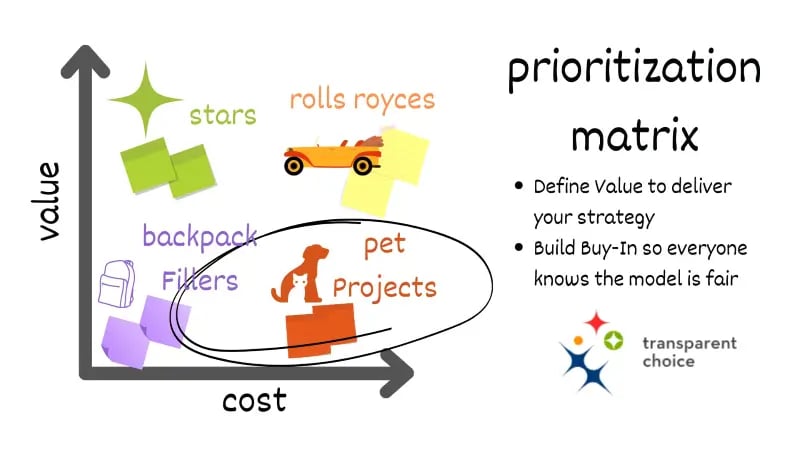Pet Projects: Mythical Unicorns or Hungry Hippos?
Updated:
Published:

Many inspirational growth stories start with a paradigm shifting project: Netflix turning entertainment into a subscription model, Under Armour and connected data, Apple and iPhone... but for every free-thinking Unicorn story there are hundreds of portfolios littered with ugly Pet Projects, which start as one exec's 'great idea' but turn out to be hungry hippos that eat all the resources and trample on your career.
It is these Pet Projects that are most often to blame when it comes to waste within a portfolio. The PMI estimates that 20% of a portfolio is waste, so this is a huge opportunity to drive value... and the good news is that it's really simple to do. You just need to tell the boss that they're wrong...
Who better to speak truth to power than Amanda Oakenfull? As a specialist in portfolio turnaround she's seen the damage a rogue pet project can cause, and provides a direct simple view on how to deal with them:
Let's review the key points.
What are Pet Projects?
Firstly let's be clear: Pet Projects are not cute. They are a pest within your portfolio that will destroy value and take your career with it.
They consume resource, but deliver little value. Essentially they are a distraction from doing what actually matters, that will reduce the value your portfolio delivers. At it's worst it could mean ignoring the basic requirements needed to keep your organization viable, the portfolio equivalent of fiddling while Rome burns.
Where do Pet Projects come from?
- Chasing the latest shiny new thing: Beware the executive who has been to a conference. Or the CEO who thinks that all the other CEOs have a new toy...
- Misplaced innovation: There is a pressure on leaders to be innovative thinkers, but many are simply not very good at it. Sadly, nobody has told them that.
- Business cases are easy to manipulate: It's really easy to produce a business case that looks good with a little creativity in excel and PowerPoint, especially if there's no culture of accountability.
- Weak prioritization process: If you don't have a proper process for project prioritization, then you can easily miss a pet, especially if you have a culture where "no" is a career limiting choice.
- Fixation on delivery: If your PMO is overly focused on delivery and the detail of execution then it's very easy to miss the basic reality that they're working on a pointless project. Don't be that PMO who is delivering something useless, really well.
How to control Pet Projects
- Broaden ideation: If ideas for projects only come from the top-down you're gong to end up with some pretty ugly pets. Why? Execs are, to put it bluntly, not the best people to come up with new ideas. The most successful initiatives come from the people close to the action, so why not source your backlog more inclusively?
- Value-based prioritization: This is critical - define what matters to the organization to drive project selection. This will quickly highlight low value projects, and create an objective framework for telling the CEO that his bright idea is not the best use of company resources. The key is that you create a process where prioritization actively rules out pet projects in favor of better ideas.
- Select projects as an organization not an individual: Projects belong to an organization, not to the person who happens to be the current custodian of a budget; therefore make sure that the organization is picking projects. This means having groups scoring projects, rather than an individuals mandating them.
- Manage budget via multiple portfolios: A favorite bear trap in project selection is to ignore projects dedicated to maintenance, risk mitigation, and efficiency in favor of bigger shinier 'transformation' initiatives. To resolve, simply split the portfolio into 'buckets' that ringfence resource to ensure that a proportion of spend is always aligned to the less sexy investments.
- Track value delivery: you need a culture of tracking value through the lifecycle of a project so you can respond if your good project morphs into a pet. People get attached to 'their' project so need to know that it's OK to put their hand up and say, "hey - this isn't a good idea anymore, let's stop".
- Learn from mistakes: How many underwhelming projects have you seen delivered that get quietly swept under the carpet? They're embarrassing, but they're also a golden opportunity to learn from your mistakes.
Prioritization Matrix: Pet Project Killer
This simple graphic is all you need to get rid of pet projects. We've seen it time and again: show a leader data that says their project is a drag on their strategy, and they'll kill it. After all what they're trying to achieve is more important than how they do it.

The key is how you build it. If you have a good prioritization process then you're set, because you have a definition of value which works. Moreover, not only do you have great data, you also build buy-in through the process of collecting it.
This means that the bright idea from the boss is exposed as, objectively speaking, poor use of organization resources, and so needs to be rejected.
Next Steps
- If you're keen to get started with AHP and want to dig deeper into how to develop your own model, we've pulled together a guide to help you do just that.
- If you're already convinced but your boss isn't, then we've got you covered, with our key facts slide deck.
- Finally if you've got an idea of your model and a sponsor backing you up, then all you need is an easy-to-use cloud based software solution... and we've got that covered too.
